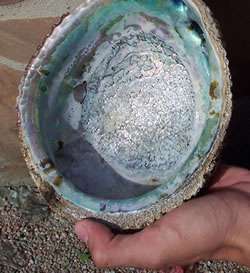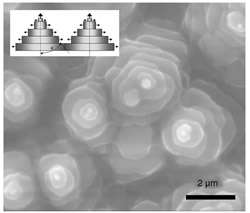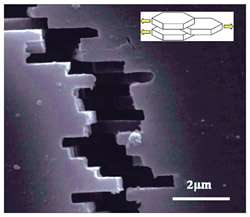Uncovering Secrets Of Abalone Body Armor

Engineering researchers at the University of California, San Diego are using the shell of a seaweed-eating snail as a guide in the development of a new generation of bullet-stopping armor. The colorful oval shell of the red abalone is highly prized as a source of nacre, or mother-of-pearl, jewelry, but the UCSD researchers are most impressed by the shell’s ability to absorb heavy blows without breaking.
Image above: The mother of pearl growth surface of abalone shell is colored due to the way light refracts as it strikes tiny ridges of calcium carbonate.
In a paper published in the Jan. 15 issue of Materials Science and Engineering A, Marc A. Meyers, a professor in UCSD’s Jacobs School of Engineering, and engineering graduate student Albert Lin explain in detail for the first time the steps taken by the abalone to produce a helmet-like home made with 95 percent calcium carbonate “tiles” and 5 percent protein adhesive. Teachers who write on blackboards know that calcium carbonate, or chalk, is weak and brittle, but Meyers and Lin have demonstrated that a highly ordered brick-like tiled structure created by the mollusk is the toughest arrangement of tiles theoretically possible.
The abalone shell investigation is one of a growing number of science-mimicking-nature, or biomimetic, projects at UCSD. For example, Meyers also is analyzing the strong, but extremely lightweight bill of the Toco Toucan, a Central and South American bird that squashes fruit and berries with its banana-shaped bill. “We are actually interested in basic research on new materials,” said Meyers. “We have turned to nature because millions of years of evolution and natural selection have given rise in many animals to some very sturdy materials with surprising mechanical properties.”

The UCSD engineering researchers showed that the terraced, Christmas tree-like surface of abalone shell has evenly spaced nucleation sites from which stacks of hexagonal “tiles” of calcium carbonate begin to grow. The top and bottom surfaces of each layer of tiles are separated by a protein adhesive, but the adhesive does not bind the edges of tiles to adjoining tiles.
Other biomimetic projects at UCSD include development of a new artificial limb technology that relies on bars and wires, new drug synthesis techniques invented to duplicate those of microorganisms, and “epidemiology-based” techniques designed to detect and defend against viruses, worms and other plagues afflicting the Internet.
Abalone shell can’t stop an AK47 bullet. However, laminates of aluminum and other materials have been disappointing as armors. Meyers argues that a careful examination of the steps taken by abalone to make their shells may help materials scientists develop similarly lightweight and effective body armor for soldiers, police, and others.
“In our search for a new generation of armors, we have exhausted the conventional possibilities, so we’ve turned to biology-inspired, or biomimetic, structures,” said Meyers, a former scientist with the U.S. Army Research Office. “The laminate structure of abalone shell has stimulated our group to development a new synthetic material using this lowly mollusk as a guide.”

Under stress, tiles of calcium carbonate can slide, absorbing energy. Because of this microstructure, the abalone shell can absorb a great deal of energy without failing.
Biomimetic researchers interested in tough materials have discovered that mollusk shells, bird bills, deer antler, animal tendon, and other biocomposite materials have recurring building plans that yield a hierarchy of structures from the molecular level to the macro scale. For example, at the nanoscale, abalone shell is made of thousands of layers of calcium carbonate “tiles,” about 10 micrometers across and 0.5 micrometer thick, or about one-one hundredth the thickness of a strand of human hair. The irregular stacks of thin tiles refract light to yield the characteristic luster of mother of pearl.
Meyers said a key to the strength of the shell is a positively charged protein adhesive that binds to the negatively charged top and bottom surfaces of the calcium carbonate tiles. The glue is strong enough to hold layers of tiles firmly together, but weak enough to permit the layers to slip apart, absorbing the energy of a heavy blow in the process. Abalones quickly fill in fissures within their shells that form due to impacts, and they also deposit “growth bands” of organic material during seasonal lulls in shell growth. The growth bands further strengthen the shells.
The precise what that building blocks of shells are assembled determines their strength, and many of those details have been unknown. “Contrary to what others have thought, the tiles abutting each other in each layer are not glued on their sides, rather they are only glued on the top and bottom, which is why adjacent tiles can separate from one another and slide when a strong force is applied,” said Meyers. “The adhesive properties of the protein glue, together with the size and shape of the calcium carbonate tiles, explain how the shell interior gives a little without breaking. On the contrary, when a conventional laminate material breaks, the whole structure is weakened.”
Meyers and Lin closely measured shell growth by coaxing abalone grown in a laboratory aquarium at UCSD’s Scripps Institution of Oceanography. They gently pushed back a section of the mantle from the shell of individual abalones, glued 15 millimeter glass slides to the shell, and later withdrew the slides at various time intervals and examined the growth of “flat pearl” with a transmission electron microscope.
The flat pearl samples revealed that about every 10 micrometers, the abalone mantle initiated calcium carbonate precipitation. At those points, tiles began to form, growing 0.5 micrometer thick and slowly outward and assuming a hexagonal shape as individual tiles in each layer gradually grew to abut a neighboring tile. Photographed from above by a microscope, the growth surface of the shells has a Christmas-tree appearance because abalones add layers of tile faster than each layer is filled in.
Meyers and Lin plan to complete their analysis of the abalone shell and generate a mathematical description that can be used by others to construct body armor based on the abalone.
Source: University of California, San Diego (by Rex Graham)

















